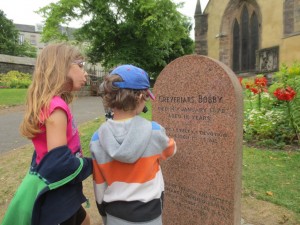By Anja Rosenke, British Columbia, Canada
We were off to Scotland. And each of us was looking forward to something different. Me, the delicious scones and walks in the countryside, my husband seeing his family – and maybe a few distilleries too. Our 8-year-old daughter hoped for a chance to spot the elusive Loch Ness Monster and to see Scotland’s most famous dog, Greyfriar’s Bobby in Edinburgh. Our hard of hearing 6-year-old son was simply excited to watch movies on the airplane and see his cousins again.
As with any trip, the planning and anticipation are a big part of the fun. So we went on Google Earth with our children and located their grandparents’ house, thousands of miles away. We made a list of places to visit and fun things to do. We showed them photos of relatives who weren’t familiar to them. We packed our suitcases and collected our passports, ready for adventure!
For the most part, our planning and preparation paid off. The kids were excited and informed about going to Scotland, talking about the colors of the flag and how the money was different. It was especially important for us to encourage this kind of dialogue with our hard-of-hearing son.
He was born with profound bilateral sensorineural hearing loss before universal newborn screening was in place in our province. And though we were fast-tracked through the cochlear implantation process and began receiving services very quickly, the late identification of his profound hearing loss meant significant language and speech delay. We would be bridging his communication deficits for several years to come.
Through our years in early intervention, my husband and I had been taught the importance of providing information about events in advance of their happening – be it a dentist appointment, seeing a new movie, or in this case, readying ourselves for big trip abroad. We enthusiastically took on the task, investing in dry-erase boards and posting a giant calendar on the wall. We made many experience books and kept a journal.
In our family, this sharing of information usually took the form of conversations accompanied by visual aids – photos, books, maps, and even as last resort, stickmen drawings on a napkin. Anything really to help our son grasp what was to come and fill in the blanks.
For any child, strategies for pre-loading and reinforcing new information can help to ease transitions and take some of the “unknown” out of new experiences. Factor in a hearing loss, and suddenly this kind of advance preparation becomes crucial.
Hearing children learn so much about the world by overhearing information in their environments throughout the day. This is called incidental learning, which isn’t to say that it’s any less important. On the contrary, putting all those bits of information together – all day, every day – helps a child piece together an understanding of the world around us. Those little snippets really add up over the years, and this is an area where our deaf and hard of hearing children are at a disadvantage. They often need to be taught things more directly instead.
Studies cite that up to 90% of what very young children know about the world comes from incidental learning. (Moog & Geers, 2003). That is a staggering and sobering statistic, when you consider the wealth of information that a hearing person is exposed to each and every day and what our deaf and hard of hearing children may miss out on.
As parents, my husband and I work hard at filling in the missing pieces of information for our son because for us, at the very heart of it is that our son be included. And in this case, inclusion means accessing the same information as everyone else. That may be a tall order, given our son’s hearing challenges but we must try.
 We arrived in Scotland and breezed through a few things on our To Do List, and eventually found ourselves in Edinburgh to see Greyfriar’s Bobby. Now, for those of you who haven’t heard the tale, Greyfriar’s Bobby was a very special dog who remained by his master’s grave in the churchyard in Edinburgh’s old town for 14 years after his master’s death. The local children visited him and cared for him during those years. And then, upon Bobby’s death, he was buried alongside his owner in the same churchyard.
We arrived in Scotland and breezed through a few things on our To Do List, and eventually found ourselves in Edinburgh to see Greyfriar’s Bobby. Now, for those of you who haven’t heard the tale, Greyfriar’s Bobby was a very special dog who remained by his master’s grave in the churchyard in Edinburgh’s old town for 14 years after his master’s death. The local children visited him and cared for him during those years. And then, upon Bobby’s death, he was buried alongside his owner in the same churchyard.
What a beautiful, heartfelt story. Naturally, we were all eager to see where this had happened. We had read the book back home, and now had walked across the city to get to the churchyard. Happily we snapped a few photos in front of the statue of Bobby and as we entered the churchyard, my son asked, “So where’s Bobby, Mom?” expecting to finally meet this famous dog.
A completely sensible question. The only problem was, we had somehow failed to convey to him that this touching tale of loyalty and love had taken place almost 150 years ago.
I was floored – could we really have missed sharing that key piece of information with our son? Perhaps we had spoken of the story in the past tense and he hadn’t realized it was the distant past. Or he simply may not have heard that part of the conversation. Whatever the case, that detail had been missed. And it meant there was no dog at the churchyard. And so the tears flowed.
It took a long time to calm our son down after that shocker. Our daughter finally managed to console him by suggesting they pick some lawn daisies to put on Bobby’s headstone. Perhaps a more dramatic gesture than most tourists show, but a fitting end to our visit.
 Situations like our son’s disappointment at not personally meeting Greyfriar’s Bobby in Scotland may not always be avoidable. But for me, our visit to the churchyard that day will serve as a good reminder as to why we as parents spend the extra effort and time in doing what we do – observing and anticipating where gaps in understanding might occur, diligently providing background information to a new topic, event or excursion, providing context or details to a situation, even just putting a name with a face.
Situations like our son’s disappointment at not personally meeting Greyfriar’s Bobby in Scotland may not always be avoidable. But for me, our visit to the churchyard that day will serve as a good reminder as to why we as parents spend the extra effort and time in doing what we do – observing and anticipating where gaps in understanding might occur, diligently providing background information to a new topic, event or excursion, providing context or details to a situation, even just putting a name with a face.
Simply put, helping to fill in the blanks where the hearing falls short.

